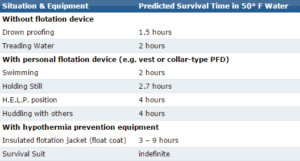Last week we discussed the four stages of physiological occurrences that happen when you are suddenly immersed in cold water. This week we will discuss cold water survival.
First and foremost, we want to stress that immersing yourself in cold water isn’t advisable. If you must enter frigid waters, for your job, for example, be sure to immerse yourself slowly and wear materials that provide thermal protection AND personal flotation. (Don’t wear cotton. When it is wet it is heavy and useless. It will not help protect you from the elements.) When possible, carry a portable VHF radio so you can convey your location and needs should an emergency arise.
(Source: Minnesota Sea Grant)
Should you find yourself in cold water you will want to conserve as much body heat as possible. Get as much of yourself out of the water as possible. Lift yourself onto a capsized boat or anything that is floating by. If you have nothing to climb onto or are not wearing a personal flotation device (PFD), enter the Heat Escape Lessening Posture (H.E.L.P.) by holding your arms tightly against your sides and folding them tightly across the chest while pulling your legs together and up toward your chest. If you are with other people, huddle together, interlock your arms and legs and press your torsos together. This will help conserve body heat and make you a larger target for rescuers. Our bodies lose heat 25x faster in cold water than in air of the same temperature; conserving body heat is crucial for survival.
(Source: Aviation Survival Technologies)
If you are ever in a cold water scenario one question you will ask yourself is if you should stay or attempt to swim. Some will say to “stay with the boat,” but if safety is not imminent within an hour then you will have to make that decision sooner rather than later. If you’re wearing a PFD and you can’t reach shore by swimming, you will still be able to float while awaiting rescue. It is important to remember that when swimming you lose heat which will make movement and breathing more difficult and exhausting. Only swim to shore when wearing a PFD and once you’ve started swimming, do not stop.
Come back next week for the third and final installment in this blog series.
To reduce risk of accident or injury, Carefree Boat Club performs regular maintenance and inspections on all vessels, equips all vessels with a ditch kit, personal flotation devices and a working radio, administers classroom and open-water training to all members, creates a comprehensive float plan prior to boat departure and provides current weather briefings.
Images and sources: Thinkstock, Beyond Cold Water Bootcamp, Boats.com, Minnesota Sea Grant and Aviation Survival Technologies
Do you have any other questions about boating without owning or the Carefree Boat Club location?
Let us know via our contact form or on Facebook or Twitter.
#CarefreeBoatClub




